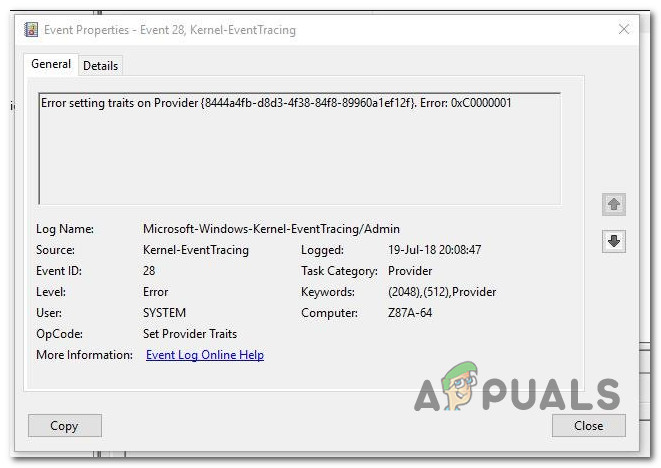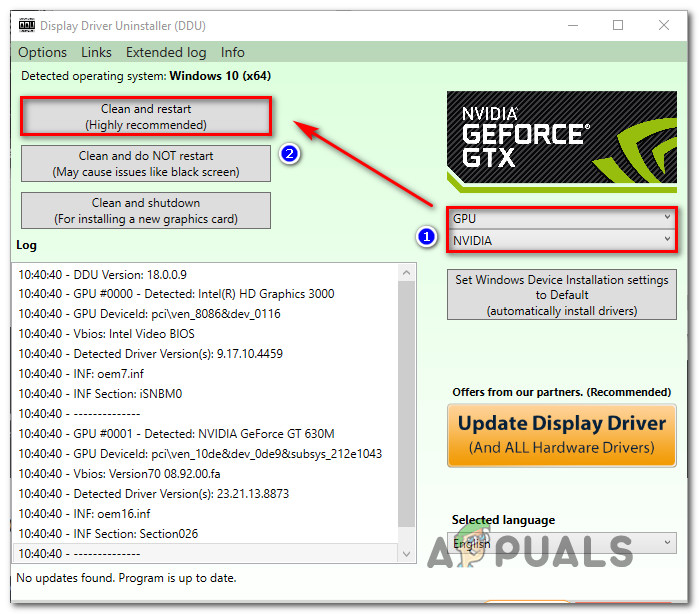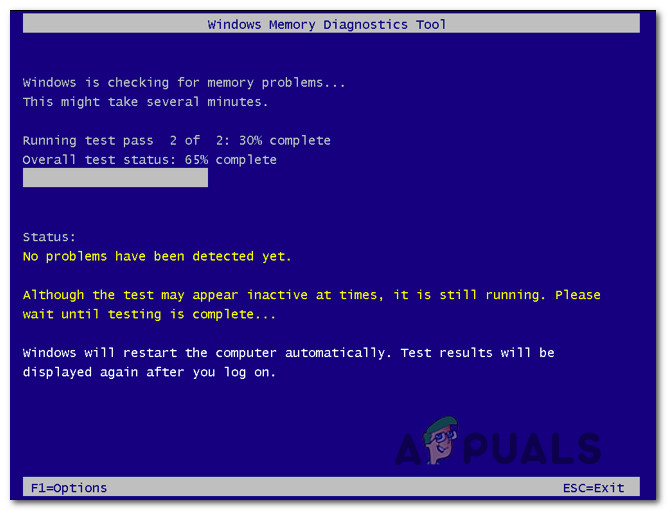[FIX] Error Setting Traits on Provider
Some Windows users are exasperated after receiving constant critical crashes that are seemingly random. Upon investigating this issue, some users are discovering constant Event Ids inside Event Viewer with the following error: Error setting traits on Provider {8444a4fb-d8d3-4f38-84f8-89960a1ef12f}. This problem is reported to occur on Windows 7, Windows 8.1, and Windows 10.

After investigating this particular issue thoroughly, it turns out that there are several different causes that might be responsible for the apparition of this error code. Here’s a shortlist of potential culprits that might be responsible for this issue:
- Missing Important Windows Update – According to a lot of affected users, this problem is confirmed to occur due to a missing Windows update containing the hotfix for this issue. Several affected users previously dealing with the same issue have confirmed that they managed to fix the issue by installing every pending update.
- Residual GPU driver files – As it turns out, you might also encounter this problem due to some type of inconsistency involving the current graphics driver that your OS is using. In this case, you should use a third party utility capable of cleaning any remnant files before reinstalling the latest GPU driver.
- Faulty RAM module – Under certain circumstances, you can expect to see this error popping up if you’re starting to deal with a faulty RAM module that is no longer able to handle the allocation of temporary files. In this case, you need to run a stress test on your memory sticks using the Windows Memory Diagnostic and replace them in case you conclude you’re dealing with failing hardware.
- System File Corruption – In some cases, you might experience these types of errors in situations where your system is dealing with some type of file corruption that is generating the event errors inside Event Viewer. To fix this problem, you should attempt to run a couple of utilities (DISM and SFC) capable of fixing the most common instances of system file corruption.
- Power draw issue – If you have a lot of connected devices that draw power from your PSU or you have recently upgraded your components without upgrading your PSU. Several affected users that were previously dealing with the same issue have fixed the issue either by disconnecting unnecessary devices or by upgrading to a more powerful PSU.
Now that you know every potential scenario that might be the root cause of the Error Setting Traits on Provider error message, here’s a list of potential fixes that other affected users have successfully used to fix this problem:
Method 1: Installing every pending Windows Update (if applicable)
As it turns out, some affected users have reported that in their case, the problem was fixed once they have installed every pending Windows update that was waiting to be installed.
If you’re Windows 10 computer is not up to date, start by installing every pending update until you bring your computer up to date
Note: In case you have already installed every Windows update available to your specific version, move down to the next potential fix below.
Here’s a quick step-by-step guide that will walk you through the entire process of installing every pending update on your Windows 10 computer:
- Open up a Run dialog box by pressing Windows key + R. Inside the text box, type ”’ms-settings:windowsupdate’ and press Enter to open up the windows update screen. When prompted by the UAC (User Account Control), click Yes to grant administrative access.

Opening the Windows Update screen Note: In case you’re not experiencing this issue on Windows 10, use ‘wuapp’ instead of the command above.
- After you’re inside the Windows Update screen, move over to the right-hand pane and start by clicking on Check for Updates. Next, follow the on-screen instructions to install every pending update.

Checking for Updates Note: If you have a lot of pending updates waiting to be installed, chances are the utility will prompt you to restart before you get the chance to install every update. If this happens, restart your computer as instructed, but make sure to return to this same screen and continue with the installation of the remaining updates once the next startup is complete.
- After you installed every pending update, reboot your computer one final time and check the Event Viewer for any new instances of the Error setting traits on Provider {8444a4fb-d8d3-4f38-84f8-89960a1ef12f}.
If the same problem is still occurring, move down to the next potential fix below.
Method 2: Cleaning Residual GPU driver files and Reinstalling it
According to some affected users, you can expect to see the Error setting traits on Provider {8444a4fb-d8d3-4f38-84f8-89960a1ef12f} issue due to some inconsistency with your GPU driver. In most documented occurrences, this problem is reported to occur after the installation of a new driver version.
If this scenario is applicable, you should take the time to install and use a 3rd party utility called Display Driver Uninstaller (DDU) to remove the current GPU driver completely and every associated dependency in order before clean installing the latest version from scratch.
In case you’re looking for step-by-step instructions on how to use the DDU utility to clean potentially corrupted GPU driver files before installing the dedicated GPU drivers again, follow the steps outlines below:
- Open your default browser and visit the official download page of the Display Driver Uninstaller.
- Once you’re inside, scroll down to the download section and click on one of the download mirrors to begin the download.

Downloading the latest version of DDU - Once the download is finally complete, use a utility like 7Zip, WinRar, or WinZip to extract the contents of the DDU archive.
- After the contents of the archive have been successfully extracted, right-click on the DDU installer and choose Run as Administrator from the context menu, then click Yes to grant admin access to the utility.
- Inside the DDU utility, choose GPU from the Select device type from the drop-down menu. Next, click on Clean and restart to begin the cleanup process.

Cleaning the GPU driver visa GPU - Once the operation is complete, reboot manually if the utility doesn’t recommend it automatically.
- Once the next startup is complete, visit your GPU manufacturer driver website and download the latest graphics driver version according to your model:
Nvidia Drivers
AMD Drivers
Intel Drivers
- Once the driver is successfully installed, reboot your computer once again and check the Event Viewer at the next systems startup to see if you still get new instances of the Error setting traits on Provider {8444a4fb-d8d3-4f38-84f8-89960a1ef12f}.
If the same problem is still occurring, move down to the next potential fix below.
Method 3: Investigating / Replacing RAM Modules
As it turns out, another potential issue that might be responsible for the apparition of the Error setting traits on Provider {8444a4fb-d8d3-4f38-84f8-89960a1ef12f} error message is a failing memory stick that is preventing temporary data from being stored temporarily.
However, before you go ahead and decide to replace your RAM sticks, you should take the time to confirm that you are actually dealing with a bad memory. To do this, you can use the Windows Memory Diagnostic tool to perform a stress test on your RAM and see if you’re dealing with some type of failing hardware.
To make matters easier for you, follow the instructions below to test your RAM using the Windows Memory Diagnostic tool:
- Open up a Run dialog box by pressing Windows key + R. Inside the text box, type ‘mdsched‘ and press Ctrl + Shift + Enter to open up the Windows Memory Diagnostic tool with admin access.

Accessing the Windows Memory Diagnostic tool via Run command Note: If you’re prompted by the UAC (User Account Control), click Yes to grant administrative privileges.
- Once you’re finally inside the Windows Memory Diagnostic issue, click on Restart Now and check for problems.

Check for RAM issues using Windows Memory Diagnostic - At the next computer startup, your computer will boot directly into the Windows Memory Diagnostic Tool. The scan will start automatically, so when it does, wait patiently until the process is complete.

Doing a scan with the Windows Memory Diagnostic tool - In case the scan confirms that you’re dealing with a RAM issue, you have no alternatives other than investing in a new RAM stick/s.
If the scan you just did inside the Windows Memory Diagnostics tool didn’t reveal any underlying issue with your RAM, move down to the next method below for additional methods of fixing the Error setting traits on Provider {8444a4fb-d8d3-4f38-84f8-89960a1ef12f}.
Method 4: Repairing System Files using SFC & DISM
Keep in mind that this particular issue is sometimes associated with some type of system file corruption, so the next step (if all the methods above have failed or where not applicable) is to run a couple of utilities that are capable of fixing corrupted system files.
If you haven’t done this already, you should take the time to run SFC (System File Checker) and DISM (Deployment Image Servicing and Management) scans in quick succession to identify and fix superficially corrupted OS files that might contribute to the apparition of the error setting traits on Provider {8444a4fb-d8d3-4f38-84f8-89960a1ef12f} events in Event Viewer.
For the best results, we recommend running both utilities in quick succession in order to maximize your chances of fixing the corrupted instances.
Start with an SFC scan since this process is generally quicker and doesn’t require you to maintain a stable Internet connection.

Note: keep in mind that once you start this scan, you should not close the elevated CMD prompt until the operation is complete to avoid the creation of logical errors on your HDD or SSD.
Once the SFC scan is complete, restart your computer and initiate a DISM scan once the next startup is complete.

Note: Before you launch this type of scan, ensure that your computer is connected to a stable Internet connection.
After the second scan is complete, restart your computer once again and see if the creation of new Event Viewer events with the Error setting traits on Provider error has been fixed.
If the same problem is still occurring, move down to the next potential fix below.
Method 5: Resolving the Power draw issue (if applicable)
In case the Event Viewer with the Error setting traits on Provider also contains mentions of the Kernel-Power 41 (63) error, your system probably creates these type of events due to a power draw issue – You’re probably experiencing this because your system is unable to draw enough power to sustain every connected component and peripheral.
If this particular scenario is applicable, you have 3 potential ways of fixing the issue:
- Disconnect non-essential peripherals – If you have a lot of peripherals with the potential to draw power from your PSU, start by disconnecting the ones that are not essential and check Event Viewer to see if you spot any new instances of the error.
- Get a USB hub with an external power supply – If you’re experiencing this issue on a laptop/ultrabook or you don’t plan on spending money on a premium PSU, a cost-effective alternative is to go for a USB hub that draws power from external sources. This should take the load off your PS and stop the creation of new errors of this kind.
- Get a more powerful PSU – If you’re encountering the Error setting traits on Provider on a desktop configuration and you’re certain this issue is occurring due to a power draw issue, the long-term solution is to go ahead and get a more powerful PSU to support your components and your component peripherals.




